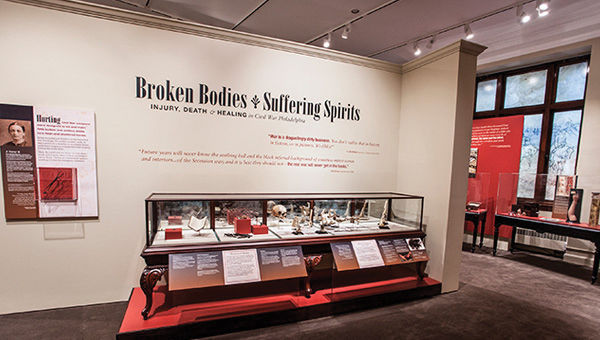I’m spellbound by the Incarnation: by our fragile, mortal bodies; by the thought of what happens to us after we die. So in Philadelphia recently, the first place I hit was the Mütter Museum.
“In 1856,” reads the brochure, “Thomas Dent Mütter (1811-1859), a professor of surgery retiring from Jefferson Medical College, offered his personal collection of more than 1,300 unique anatomic and pathological materials to The College of Physicians of Philadelphia…The museum opened in 1863…Today the Mütter Museum’s collection includes more than 25,000 fascinating objects.”
I am all for fascinating objects and, within certain parameters, a museum that bills itself as “disturbingly informative.” The curators haven’t been able to resist a nod to the ghoulish.
But the nod is tempered by sensitivity — a current exhibit, for example, is called “Broken Bodies and Suffering Spirits: Injury, Death and Healing in Civil War Philadelphia.” And for the most part, the specimens and skeletons and cross-sections and slides are presented for the viewer to make of it what she will.
Getting my bearings takes a while.
“Spinal Marrow”: a 4- to 5-inch piece of what looks like fish cartilage, floating in a glass jar.
“Fractured Lower Left Leg with Foot.”
“Skull, saved by Judy and George Wohlreich.” Saved from what? Where? Why?
“Inscribed on the side, the skull is identified as that of Andrejew Sokoloff, a member of the Russian fanatic Skopzi sect of the castrated. He died after removing his own testicles.”
A sepia portrait of a shirtless man, his torso terribly disfigured, his eyelashes shadowing his cheek. “Photograph showing a case of neurofibromatosis. Chenallier, age 28. Admitted Hôpital del Cliniques, Paris, Nov. 29, 1864. Patient of August Nélaton, M.D. Operated on Dec. 19, 1864; died six days later.”
“Piece of Epidermis from the Back of President Garfield.”
“Piece of the Thorax of John Wilkes Booth.”
“The Soap Lady,” whose corpse transformed into a waxy substance called adipocere that now looks lightly coated with dirt.
“Cabinet portrait of Admiral Dot, a pituitary dwarf who performed with P.T. Barnum’s circus and caravan.”
The Mütter Giant, from Kentucky, identity unknown. “The largest femur of any known giant skeleton.”
The Curious Case of Harry Eastlack, 11-17-33 to 11-11-73. “By 1958, at the age of 25, he was admitted to an institution for the chronically disabled. Harry was eventually bedridden and spent the rest of his life in considerable pain. He died of pneumonia on Nov. 11, 1973, six days short of his 40th birthday.”
Before Harry died he requested that his body be used to help understand more about his disease. Harry never met another person with FOP while he was alive, but in death he has helped to unlock many of the mysteries of this disease.
FOP — Fibrodysplasia Ossificans Progressiva — is, according to the International FOP Association, “one of the rarest, most disabling genetic conditions known to medicine. It causes bone to form in muscles, tendons, ligaments and other connective tissues. Bridges of extra bone develop across joints, progressively restricting movement and forming a second skeleton that imprisons the body in bone. There are no other known examples in medicine of one normal organ system turning into another.”
Gunshot Fracture. Infant with Congenital Clubfoot. What can go very, very wrong with your teeth if you have syphilis.
I keep wanting to kneel, to cross myself, to apologize. I try to gaze upon the people whose bodies and body parts I am viewing with the same look of sympathy as if they’d still been alive.
Bezoar or hairball. “Presented by D. Max Kasser, April, 1964.” The imagination falters. A fancy dress ball? A potluck supper?
Plaster cast made from the bodies of Chang and Eng, the original “Siamese Twins.”
“Teratology: the branch of science concerned with the production, development, anatomy, and classification of malformed fetuses.” Fetuses with heads that are too big, intestines that have burst through the stomach, flippers for limbs.
If we believe in a loving God, we have to acknowledge what a loving God allows. And what a loving God allows us to do to ourselves and to each other.
Dr. Chevalier Jackson (1865-1958) removed over 2,000 foreign bodies, swallowed by patients, with “consistently good results.” And here the collection is, arranged in long narrow wooden drawers with hand-written labels: “Pins,” “Hardware,” “Bone Fragments.” Among the Jewelry and Buttons lies a silver crucifix, attached by a length of broken chain to four pale blue rosary beads.
A foot, affixed firmly to a board.
The mouth of the Soap Lady, open in a silent scream.
“We like to see people suffer,” a priest once observed.
If other people are suffering, maybe we won’t have to.
If other people are suffering, maybe we’re not alone.
“Christ made amends for all of humanity,” a newly sober young woman, groping to make sense of a tortured past and an unknown future, had mused to me that morning. “And when we suffer, we get to somehow…help him. We get to make amends, too.”
“Died six days later.”
“Performed with P.T. Barnum’s circus and caravan.”
“Harry never met another person with FOP while he was alive.”
Heather King is the author of “Parched: A Memoir,” “Redeemed: Stumbling Toward God,” and “Shirt of Flame: A Year with St. Therese of Lisieux.” She lives in Los Angeles.

